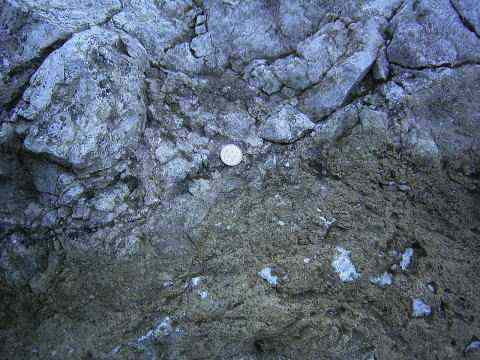Horado Mine
Horado-Komi, Seki city, Gifu pref., Japan
Occurrence
Moderate-T hydrothermal skarn deposit
Skarn formed by the early Paleocene (65 Ma) Koka Granite intruded in the Middle Jurassic (170 Ma) Nabi unit, a member of the Tamba-Mino-Ashio accretionary complex. The moderate temperature hydrothermal deposit associated with skarn was formed by the quartz porphyry and granodiorite porphyry arc-shaped dikes of the Okumino Rhyolites. The Koka Granite is I-type (Magnetite-series). The age of limestone is probably Permian (270 Ma). Approximately 1 km apart from the Koka Granite, the heat source. The sulfide deposits are in contact with the quartz porphyry and the granodiorite porphyry dikes. The Arc-shaped dikes and the Koka Granite are considered as members of the Cretaceous Horado Caldera Complex. Ages of sedimentary rocks were determined by radiolarians, and granite by K-Ar radiometric dating. The Mokusuke deposit, the Sugihara deposit, and the Umehogi deposit are known.

Skarn outcrop in the Nabi Unit. The gray part above the scale coin is metamorphosed limestone, and the lower part is skarn mainly composed of grossular, calcite, and quartz. Fibrous vesuvianite has been reported from this outcrop. There are many outcrops of hornfels and silicified rocks around here.
Reported Minerals
- Cuprite
- Erythrite
- Calcite
- Malachite
- Azurite
- Cerussite
- Linarite
- Mimetite
- Wulfenite
- Hydrozincite
- Pyrite
- Chalcopyrite
- Sphalerite
- Galena
- Arsenopyrite
- Cobaltite
- Molybdenite
- Greenockite
- Grossular
- Diopside
- Hedenbergite
- Vesuvianite
- Wollastonite
- Ilvaite
- Tremolite
- Prehnite
- Hemimorphite
- Zincsilite
- Apophyllite
- Laumontite
- Quartz
Mineral Assemblages
- Grossular - Calcite - Cobaltite - Erythrite
- Grossular - Calcite - Diopside - Prehnite
- Grossular - Calcite - Tremolite
- Grossular - Vesuvianite - Calcite
- Grossular - Quartz - Ilvaite
History
- 1910: Began to mine the deposit.
- 1920: Closed.
Localities
- Horado Mine (Zn-Co)
- Komoto Mine (Magnetite)
- Kawai Mine (Fe-rich)
- Nakatatsu Mine (Zn)
- Ogibira Mine (Arsenate)